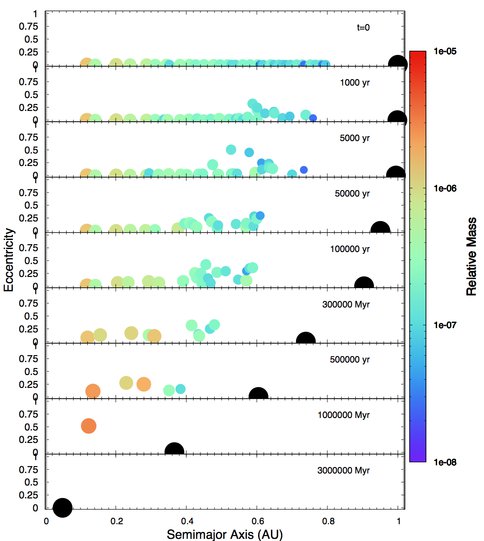2010 Annual Science Report
 University of Hawaii, Manoa
Reporting | SEP 2009 – AUG 2010
University of Hawaii, Manoa
Reporting | SEP 2009 – AUG 2010
Formation and Prospect of the Detection of Habitable Super-Earths Around Low-Mass Stars: Reconciling Theory With Observation
Project Summary
We have studied the formation of terrestrial planets around M stars with a migrating giant planet. Results indicate that terrestrial planet formation is possible at somewhat large distances where the giant planet captures the terrestrial body in resonance, and the two objects migrate to close-in orbits.
Project Progress
Models of planet formation around M stars suggest that majority of these planets may be of Neptune size or smaller. The detection of Jupiter-like planets in close-in orbit around M stars raises the possibility that many of these systems may harbor additional planets, perhaps of smaller sizes and in smaller orbits. These planets are potentially detectable through transit photometry and transit timing variation method. The orbital architecture of these objects plays an important role in their detectability and is strongly affected by the migration of their giant planets. To determine the connection between the formation, dynamical evolution, and detectability of small planets and the dynamics of a migrating giant body around M stars, we have studied the late stage of terrestrial planet formation during the migration of a Jupiter-sized planet. Results indicate that the in-situ formation of close-in terrestrial planets may be unlikely as most of protoplanetary embryos are scattered out of the system through their interactions with the migrating giant planet. However, Earth-sized and super-Earth objects may form and be captured in mean-motion resonances with the giant body and migrate to stable orbital configurations (Figure 1). We discuss the possibility of such orbits, and the probability of the detection of their corresponding planets for different values of the physical and orbital parameters of the protoplanetary disk and the migrating giant body. Given that the habitable zones of M stars are in close distances (i.e., 20-50 day orbits), we will also present results of the simulations of the formation of habitable planets in such systems, and discuss the possibility of their detection.
Figure 1. Formation of terrestrial planets as the giant planet (black circle) migrates. As shown here, terrestrial planet may form before the giant planet is reached to close orbits. The two planets may be captured in resonance and continue migration to close-in orbits.
Publications
- Haghighipour, N. (2010). The Stability and Prospects of the Detection of Terrestrial/Habitable Planets in Multiplanet and Multiple Star Systems. Extrasolar planets in multi-body systems: theory and observations. Torun, Poland.
-
PROJECT INVESTIGATORS:
-
RELATED OBJECTIVES:
Objective 1.1
Formation and evolution of habitable planets.
Objective 1.2
Indirect and direct astronomical observations of extrasolar habitable planets.

